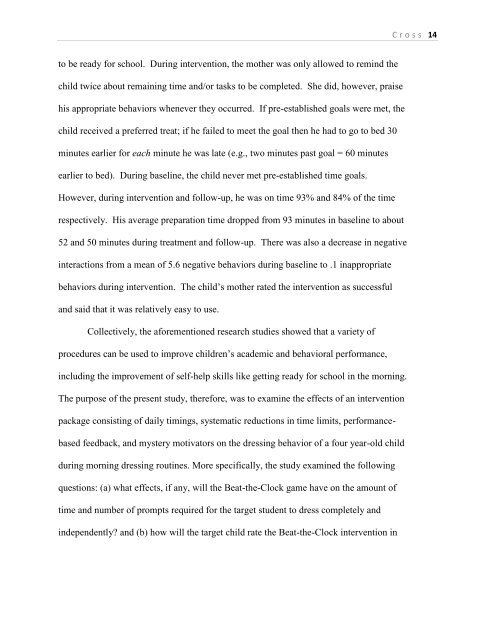THE EFFECTS OF A TIMER AND MYSTERY MOTIVATORS ON THE ...
THE EFFECTS OF A TIMER AND MYSTERY MOTIVATORS ON THE ...
THE EFFECTS OF A TIMER AND MYSTERY MOTIVATORS ON THE ...
Create successful ePaper yourself
Turn your PDF publications into a flip-book with our unique Google optimized e-Paper software.
C r o s s 14<br />
to be ready for school. During intervention, the mother was only allowed to remind the<br />
child twice about remaining time and/or tasks to be completed. She did, however, praise<br />
his appropriate behaviors whenever they occurred. If pre-established goals were met, the<br />
child received a preferred treat; if he failed to meet the goal then he had to go to bed 30<br />
minutes earlier for each minute he was late (e.g., two minutes past goal = 60 minutes<br />
earlier to bed). During baseline, the child never met pre-established time goals.<br />
However, during intervention and follow-up, he was on time 93% and 84% of the time<br />
respectively. His average preparation time dropped from 93 minutes in baseline to about<br />
52 and 50 minutes during treatment and follow-up. There was also a decrease in negative<br />
interactions from a mean of 5.6 negative behaviors during baseline to .1 inappropriate<br />
behaviors during intervention. The child’s mother rated the intervention as successful<br />
and said that it was relatively easy to use.<br />
Collectively, the aforementioned research studies showed that a variety of<br />
procedures can be used to improve children’s academic and behavioral performance,<br />
including the improvement of self-help skills like getting ready for school in the morning.<br />
The purpose of the present study, therefore, was to examine the effects of an intervention<br />
package consisting of daily timings, systematic reductions in time limits, performancebased<br />
feedback, and mystery motivators on the dressing behavior of a four year-old child<br />
during morning dressing routines. More specifically, the study examined the following<br />
questions: (a) what effects, if any, will the Beat-the-Clock game have on the amount of<br />
time and number of prompts required for the target student to dress completely and<br />
independently? and (b) how will the target child rate the Beat-the-Clock intervention in
















